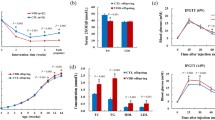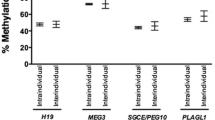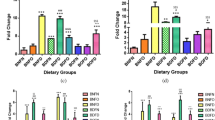Abstract
Vitamin B12 deficiency is a critical problem worldwide and peri-conceptional deficiency of this vitamin is associated with the risk of complex cardio-metabolic diseases. Nutritional perturbations during these stages of development may lead to changes in the fetal epigenome. Using Wistar rat model system, we have earlier shown that low maternal B12 levels are associated with low birth weight, adiposity, insulin resistance, and increased triglyceride levels in the offspring, which might predispose them to the risk of cardio-metabolic diseases in adulthood. In this study, we have investigated the effects of maternal B12 deficiency on genome-wide DNA methylation profile of the offspring and the effect of rehabilitation of mothers with B12 at conception. We have performed methylated DNA immunoprecipitation sequencing of liver from pups in four groups of Wistar rats: Control (C), B12-restricted (B12R), B12-rehabilitated at conception (B12RC), and B12-rehabilitated at parturition (B12RP). We have analyzed differentially methylated signatures between the three groups as compared to controls. We have identified a total of 214 hypermethylated and 142 hypomethylated regions in the 10 kb upstream region of transcription start site in pups of B12-deficient mothers, which are enriched in genes involved in fatty acid metabolism and mitochondrial transport/metabolism. B12 rehabilitation at conception and parturition is responsible for reversal of methylation status of many of these regions to control levels suggesting a causal association with metabolic phenotypes. Thus, maternal B12 restriction alters DNA methylation of genes involved in important metabolic processes and influences the offspring phenotype, which is reversed by B12 rehabilitation of mothers at conception.






Similar content being viewed by others
Data availability
Relevant information has been provided in the paper. All the information about DMRs and their respective genomic coordinates have been provided in Supplementary Tables.
Abbreviations
- MeDIP:
-
Methylated DNA immunoprecipitation
- PPAR:
-
Peroxisome proliferator-activated receptor
- DMR:
-
Differentially methylated regions
- MACS:
-
Model-based analysis for Chip-Seq
- TSS:
-
Transcription start site
- UTR:
-
Untranscribed region
- ACAA2:
-
Acetyl-coA acyltransferase 2
- CYP4A1/A3:
-
Cytochrome P450 family 4 subfamily A1/A3
- ECSIT:
-
Evolutionary conserved signaling intermediate in Toll pathway, mitochondrial
- TOMM4OB:
-
Translocase of outer mitochondrial membrane 40 blocking peptide
- CYCS:
-
Cytochrome C somatic
- NCAM2:
-
Neural cell adhesion molecule 2
- RT1:
-
N1/N2-cell surface antigen
- ADIPOR2:
-
Adiponectin receptor 2
References
Kaplan GA, Keil JE (1993) Socioeconomic factors and cardiovascular disease: a review of the literature. Circulation 88:1973–1998
Yu E, Rimm E, Qi L et al (2016) Diet, lifestyle, biomarkers, genetic factors, and risk of cardiovascular disease in the nurses' health studies. Am J Public Health 106:1616–1623
Drake AJ, Walker BR (2004) The intergenerational effects of fetal programming: non-genomic mechanisms for the inheritance of low birth weight and cardiovascular risk. J Endocrinol 180:1–16
Jimenez-Chillaron JC, Isganaitis E, Charalambous M et al (2009) Intergenerational transmission of glucose intolerance and obesity by in utero undernutrition in mice. Diabetes 58:460–468
Langley-Evans SC (2006) Developmental programming of health and disease. Proc Nutr Soc 65:97–105
Jang H, Serra C (2014) Nutrition, epigenetics, and diseases. Clin Nutr Res 3:1–8
Weaver IC, Champagne FA, Brown SE et al (2005) Reversal of maternal programming of stress responses in adult offspring through methyl supplementation: altering epigenetic marking later in life. J Neurosci 25:11045–11054
Uauy R, Kain J, Corvalan C (1764S) How can the developmental origins of health and disease (DOHaD) hypothesis contribute to improving health in developing countries? Am J Clin Nutr 94:1759S–1764S
Yajnik CS, Deshpande SS, Jackson AA et al (2008) Vitamin B12 and folate concentrations during pregnancy and insulin resistance in the offspring: the Pune Maternal Nutrition Study. Diabetologia 51:29–38
Rosenberg IH (2008) Metabolic programming of offspring by vitamin B12/folate imbalance during pregnancy. Diabetologia 51:6–7
Kulkarni A, Dangat K, Kale A et al (2011) Effects of altered maternal folic acid, vitamin B12 and docosahexaenoic acid on placental global DNA methylation patterns in Wistar rats. PLoS ONE 6:e17706
Kumar KA, Lalitha A, Pavithra D et al (2013) Maternal dietary folate and/or vitamin B12 restrictions alter body composition (adiposity) and lipid metabolism in Wistar rat offspring. J Nutr Biochem 24:25–31
Chmurzynska A (2010) Fetal programming: link between early nutrition, DNA methylation, and complex diseases. Nutr Rev 68:87–98
Kumar KA, Lalitha A, Reddy U et al (2014) Chronic maternal vitamin B12 restriction induced changes in body composition & glucose metabolism in the Wistar rat offspring are partly correctable by rehabilitation. PLoS ONE 9:e112991
Ahmad S, Kumar KA, Basak T et al (2013) PPAR signaling pathway is a key modulator of liver proteome in pups born to vitamin B(12) deficient rats. J Proteomics 91:297–308
Marsh EN (1999) Coenzyme B12 (cobalamin)-dependent enzymes. Essays Biochem 34:139–154
Brustolin S, Giugliani R, Felix TM (2010) Genetics of homocysteine metabolism and associated disorders. Braz J Med Biol Res 43:1–7
Niculescu MD, Zeisel SH (2335S) Diet, methyl donors and DNA methylation: interactions between dietary folate, methionine and choline. J Nutr 132:2333S–2335S
Sinclair KD, Allegrucci C, Singh R et al (2007) DNA methylation, insulin resistance, and blood pressure in offspring determined by maternal periconceptional B vitamin and methionine status. Proc Natl Acad Sci USA 104:19351–19356
Lee HS (2015) Impact of maternal diet on the epigenome during in utero life and the developmental programming of diseases in childhood and adulthood. Nutrients 7:9492–9507
Jousse C, Parry L, Lambert-Langlais S et al (2011) Perinatal undernutrition affects the methylation and expression of the leptin gene in adults: implication for the understanding of metabolic syndrome. FASEB J 25:3271–3278
Adaikalakoteswari A, Finer S, Voyias PD et al (2015) Vitamin B12 insufficiency induces cholesterol biosynthesis by limiting s-adenosylmethionine and modulating the methylation of SREBF1 and LDLR genes. Clin Epigenet 7:14
Kok DE, Dhonukshe-Rutten RA, Lute C et al (2015) The effects of long-term daily folic acid and vitamin B12 supplementation on genome-wide DNA methylation in elderly subjects. Clin Epigenet 7:121
Clark JD, Gebhart GF, Gonder JC et al (1997) Special report: the 1996 guide for the care and use of laboratory animals. ILAR J 38:41–48
Sati S, Tanwar VS, Kumar KA et al (2012) High resolution methylome map of rat indicates role of intragenic DNA methylation in identification of coding region. PLoS ONE 7:e31621
Zhang Y, Liu T, Meyer CA et al (2008) Model-based analysis of ChIP-Seq (MACS). Genome Biol 9:R137
Wang J, Duncan D, Shi Z et al (2013) WEB-based GEne SeT AnaLysis Toolkit (WebGestalt): update 2013. Nucleic Acids Res 41:W77–83
Krueger F, Andrews SR (2011) Bismark: a flexible aligner and methylation caller for Bisulfite-Seq applications. Bioinformatics 27:1571–1572
Chavez L, Jozefczuk J, Grimm C et al (2010) Computational analysis of genome-wide DNA methylation during the differentiation of human embryonic stem cells along the endodermal lineage. Genome Res 20:1441–1450
Dou J, Xu W, Ye B et al (2012) Serum vitamin B12 levels as indicators of disease severity and mortality of patients with acute-on-chronic liver failure. Clin Chim Acta 413:1809–1812
Mcmillen IC, Robinson JS (2005) Developmental origins of the metabolic syndrome: prediction, plasticity, and programming. Physiol Rev 85:571–633
Symonds ME, Sebert SP, Hyatt MA et al (2009) Nutritional programming of the metabolic syndrome. Nat Rev Endocrinol 5:604–610
Anderson OS, Sant KE, Dolinoy DC (2012) Nutrition and epigenetics: an interplay of dietary methyl donors, one-carbon metabolism and DNA methylation. J Nutr Biochem 23:853–859
Frenkel EP (1973) Abnormal fatty acid metabolism in peripheral nerves of patients with pernicious anemia. J Clin Invest 52:1237–1245
Aoyama T, Hardwick JP, Imaoka S et al (1990) Clofibrate-inducible rat hepatic P450s IVA1 and IVA3 catalyze the omega- and (omega-1)-hydroxylation of fatty acids and the omega-hydroxylation of prostaglandins E1 and F2 alpha. J Lipid Res 31:1477–1482
Mayer B, Lieb W, Gotz A et al (2005) Association of the T8590C polymorphism of CYP4A11 with hypertension in the MONICA Augsburg echocardiographic substudy. Hypertension 46:766–771
Laffer CL, Gainer JV, Waterman MR et al (2008) The T8590C polymorphism of CYP4A11 and 20-hydroxyeicosatetraenoic acid in essential hypertension. Hypertension 51:767–772
Kaikaus RM, Sui Z, Lysenko N et al (1993) Regulation of pathways of extramitochondrial fatty acid oxidation and liver fatty acid-binding protein by long-chain monocarboxylic fatty acids in hepatocytes. Effect of inhibition of carnitine palmitoyltransferase I. J Biol Chem 268:26866–26871
Vogel RO, Janssen RJ, Van Den Brand MA et al (2007) Cytosolic signaling protein Ecsit also localizes to mitochondria where it interacts with chaperone NDUFAF1 and functions in complex I assembly. Genes Dev 21:615–624
Benit P, Chretien D, Kadhom N et al (2001) Large-scale deletion and point mutations of the nuclear NDUFV1 and NDUFS1 genes in mitochondrial complex I deficiency. Am J Hum Genet 68:1344–1352
Diaz F, Kotarsky H, Fellman V et al (2011) Mitochondrial disorders caused by mutations in respiratory chain assembly factors. Semin Fetal Neonatal Med 16:197–204
Xiao C, Shim JH, Kluppel M et al (2003) Ecsit is required for Bmp signaling and mesoderm formation during mouse embryogenesis. Genes Dev 17:2933–2949
Kuida K, Haydar TF, Kuan CY et al (1998) Reduced apoptosis and cytochrome c-mediated caspase activation in mice lacking caspase 9. Cell 94:325–337
Yakubu D, Mostyn A, Hyatt M et al (2007) Ontogeny and nutritional programming of mitochondrial proteins in the ovine kidney, liver and lung. Reproduction 134:823–830
Altmann S, Murani E, Schwerin M et al (2012) Somatic cytochrome c (CYCS) gene expression and promoter-specific DNA methylation in a porcine model of prenatal exposure to maternal dietary protein excess and restriction. Br J Nutr 107:791–799
Radovica I, Fridmanis D, Silamikelis I et al (2014) Association between CETP, MLXIPL, and TOMM40 polymorphisms and serum lipid levels in a Latvian population. Meta Gene 2:565–578
Salakhov RR, Goncharova IA, Makeeva OA et al (2014) TOMM40 gene polymorphism association with lipid profile. Genetika 50:222–229
Mehrabian M, Qiao JH, Hyman R et al (1993) Influence of the apoA-II gene locus on HDL levels and fatty streak development in mice. Arterioscler Thromb 13:1–10
Ghemrawi R, Pooya S, Lorentz S et al (2013) Decreased vitamin B12 availability induces ER stress through impaired SIRT1-deacetylation of HSF1. Cell Death Dis 4:e553
Fabris L, Strazzabosco M, Crosby HA et al (2000) Characterization and isolation of ductular cells coexpressing neural cell adhesion molecule and Bcl-2 from primary cholangiopathies and ductal plate malformations. Am J Pathol 156:1599–1612
Koplay M, Gulcan E, Ozkan F (2011) Association between serum vitamin B12 levels and the degree of steatosis in patients with nonalcoholic fatty liver disease. J Investig Med 59:1137–1140
Singhal NK, Li S, Arning E et al (2015) Changes in methionine metabolism and histone H3 trimethylation are linked to mitochondrial defects in multiple sclerosis. J Neurosci 35:15170–15186
Acknowledgements
The authors acknowledge the efforts by Vaibhav Jain for his valuable suggestions in the MeDIP analysis. Dr. Anju Sharma and Dr. Shamima Akhtar also provided their critical inputs and helped in proofreading the manuscript. The authors also acknowledge the Sequencing and computation facility at CSIR-IGIB.
Funding
This work was financially supported by Council of Scientific and Industrial Research (CSIR), Ministry of Science and Technology, Government of India, India (EpiHED; BSC0118″ and GEHeaD; MLP1804). The funding organization had no role in the design of experiments. The authors declare no conflict of interest. No assistance has been taken from any external organization while performing the sequencing experiments and writing the manuscript.
Author information
Authors and Affiliations
Contributions
VST, did the MeDIP and CpG-specific (bisulfite) methylation experiments, was involved in analysis and wrote the initial draft of the paper. VS and SG (Sourav) were involved in bioinformatics work. SS (Satish) helped in the methylation experiments and data analysis. SG (Subhoshree) was involved in bisulfite capture experiments and provided critical inputs in improving the manuscript. LK, KAK, PK, and VJ were involved in all the animal experiments. SSB, SKV, AP, and MS were involved in sequencing experiments. MR, RM, GRC, and SS (Shantanu) were involved in designing the study including animal experiments. GRC and SS were also involved in data analysis and writing the manuscript. All authors read and approved the contents in the manuscript and declare no conflict of interest.
Corresponding authors
Additional information
Publisher's Note
Springer Nature remains neutral with regard to jurisdictional claims in published maps and institutional affiliations.
Electronic supplementary material
Below is the link to the electronic supplementary material.


Rights and permissions
About this article
Cite this article
Tanwar, V.S., Ghosh, S., Sati, S. et al. Maternal vitamin B12 deficiency in rats alters DNA methylation in metabolically important genes in their offspring. Mol Cell Biochem 468, 83–96 (2020). https://doi.org/10.1007/s11010-020-03713-x
Received:
Accepted:
Published:
Issue Date:
DOI: https://doi.org/10.1007/s11010-020-03713-x




